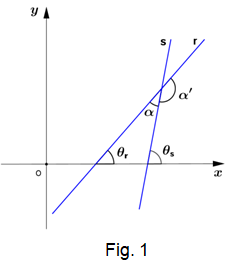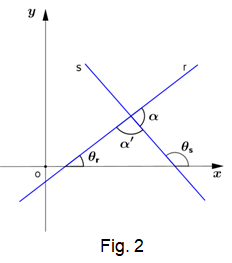Geometria Analítica: Estudo da Reta



Ângulo entre duas retas: Demonstração do 1º Caso
Nenhuma das retas é paralela ao eixo y.
Neste caso temos as duas situações abaixo para analisar:


- Na figura 1 o teorema do ângulo externo diz que $\alpha = \theta_s - \theta_r$.
Portanto:
$tg \ \alpha = tg (\theta_s - \theta_r) = \dfrac{tg \ \theta_s - tg \ \theta_r}{1+ tg \ \theta_s . tg \ \theta_r}$
$tg \ \theta_s = m_s$
$tg \ \theta_r = m_r$
$tg \ \theta_s = m_s$
$tg \ \theta_r = m_r$
Então:
$tg \ \alpha = \dfrac{m_s - m_r}{1+ m_s . m_r}$
- Na figura 2 o teorema do ângulo externo diz que $\alpha ' = \theta_s - \theta_r$
Mas,
$\theta \ ' = 180º - \alpha$
Portanto:
$180º - \alpha = \theta_s - \theta_r$
$tg(180º - \alpha) = tg(\theta_s - \theta_r)$
$\dfrac{tg 180º - tg \ \alpha}{1+tg 180º . tg \ \alpha} = \dfrac{tg \ \theta_s - tg \ \theta_r}{1+ tg \ \theta_s . tg \ \theta_r}$
$\dfrac{0-tg \ \alpha}{1 + 0.tg \ \alpha} = \dfrac{tg \ \theta_s - tg \ \theta_r}{1 + tg \ \theta_s . tg \ \theta_r}$
$-tg \ \alpha = \dfrac{m_s - m_r}{1+m_s . m_r}$
$tg(180º - \alpha) = tg(\theta_s - \theta_r)$
$\dfrac{tg 180º - tg \ \alpha}{1+tg 180º . tg \ \alpha} = \dfrac{tg \ \theta_s - tg \ \theta_r}{1+ tg \ \theta_s . tg \ \theta_r}$
$\dfrac{0-tg \ \alpha}{1 + 0.tg \ \alpha} = \dfrac{tg \ \theta_s - tg \ \theta_r}{1 + tg \ \theta_s . tg \ \theta_r}$
$-tg \ \alpha = \dfrac{m_s - m_r}{1+m_s . m_r}$
Ou seja,
$tg \ \alpha = - \dfrac{m_s - m_r}{1+m_s . m_r}$
Sabemos que a tangente de um ângulo agudo é positivo, portanto as duas fórmulas acima podem ser resumidas em uma só conforme abaixo:
$\colorbox{lightgreen}{$tg \ \alpha = \left| \dfrac{m_s - m_r}{1+m_s . m_r} \right|$}$
Exemplo:
Determine o ângulo agudo entre as retas r: 2x + 3y + 2 = 0 e s: 3x - 2y +3 = 0.
Vamos determinar o coeficiente angular das retas reescrevendo-as na forma reduzida y = mx + q:
Reta r:
$-6x + 3y + 9 = 0$
$3y = 6x - 9 \quad$(dividindo por 3)
$y = 2x - 3$
$3y = 6x - 9 \quad$
$y = 2x - 3$
Comparando com a forma reduzida da equação concluímos que:
$\colorbox{yellow}{$m_r=2$}$
Reta s:
$6x + 2y - 4 = 0$
$2y = - 6x +4 \quad$(dividindo por 2)
$y = -3x + 4$
$2y = - 6x +4 \quad$
$y = -3x + 4$
Comparando com a forma reduzida da equação concluímos que:
$\colorbox{yellow}{$m_s=-3$}$
Aplicando a fórmula:
$tg \ \alpha = \left| \dfrac{m_s - m_r}{1+m_s . m_r} \right|$
$ tg \ \alpha = \left| \dfrac{-3-2}{1+(-3).(2)} \right|$
$ tg \ \alpha = \left| \dfrac{-3-2}{1-6} \right|$
$tg \ \alpha = \left| \dfrac{-5}{-5} \right|$
$tg \ \alpha = 1$
$\alpha = arctg \ 1$
$\alpha = 45º$
$ tg \ \alpha = \left| \dfrac{-3-2}{1+(-3).(2)} \right|$
$ tg \ \alpha = \left| \dfrac{-3-2}{1-6} \right|$
$tg \ \alpha = \left| \dfrac{-5}{-5} \right|$
$tg \ \alpha = 1$
$\alpha = arctg \ 1$
$\alpha = 45º$
$\alpha = 45º$
1
Equação geral da reta
2
Equação geral da reta: Demonstração
3
Equação geral da reta: Exemplos e Exercícios
4
Equação reduzida da reta
5
Demonstração da equação reduzida, coeficiente angular e linear:
6
Demonstração da equação reduzida, coeficiente angular e linear: Exemplos e Exercícios
7
Demonstração da equação reduzida, coeficiente angular e linear: Exemplos e Exercícios
8
Equação da reta a partir de dois pontos da reta
9
Equação da reta a partir de dois pontos da reta: Demonstração
10
Equação da reta a partir de dois pontos da reta: Exemplos e Exercícios
11
Equação da reta a partir do coeficiente angular(m) e de um ponto
12
Equação da reta a partir do coeficiente angular(m) e de um ponto: Demonstração
13
Equação da reta a partir do coeficiente angular(m) e de um ponto $A(x_1, y_1)$ de $r$: Exemplos/Exercícios
14
Equação segmentária da reta
15
Equação segmentária da reta: Demonstração
16
Equação segmentária da reta: Exemplos e Exercícios
17
Retas horizontais e verticais
18
Retas paralelas
19
Retas coincidentes
20
Retas concorrentes
21
Ângulo entre duas retas
22
Ângulo entre duas retas: Demonstração do 1º Caso
23
Ângulo entre duas retas: Demonstração do 2º Caso
24
Distância de um ponto a uma reta
25
Distância de um ponto a uma reta: Exemplos e Exercícios





